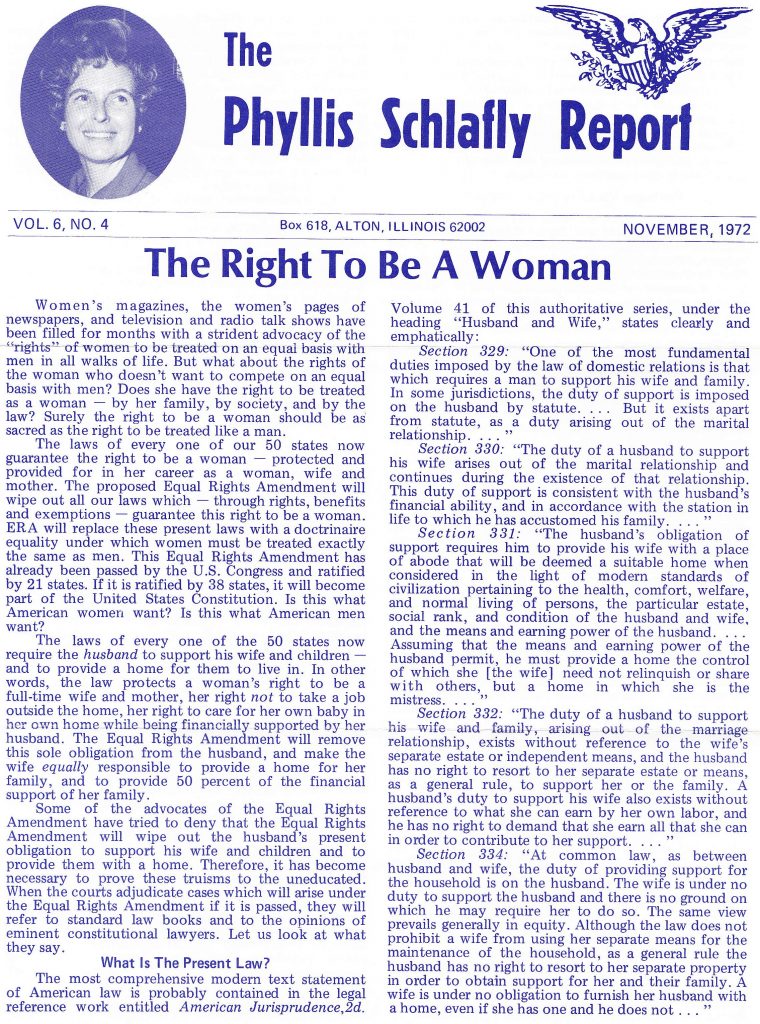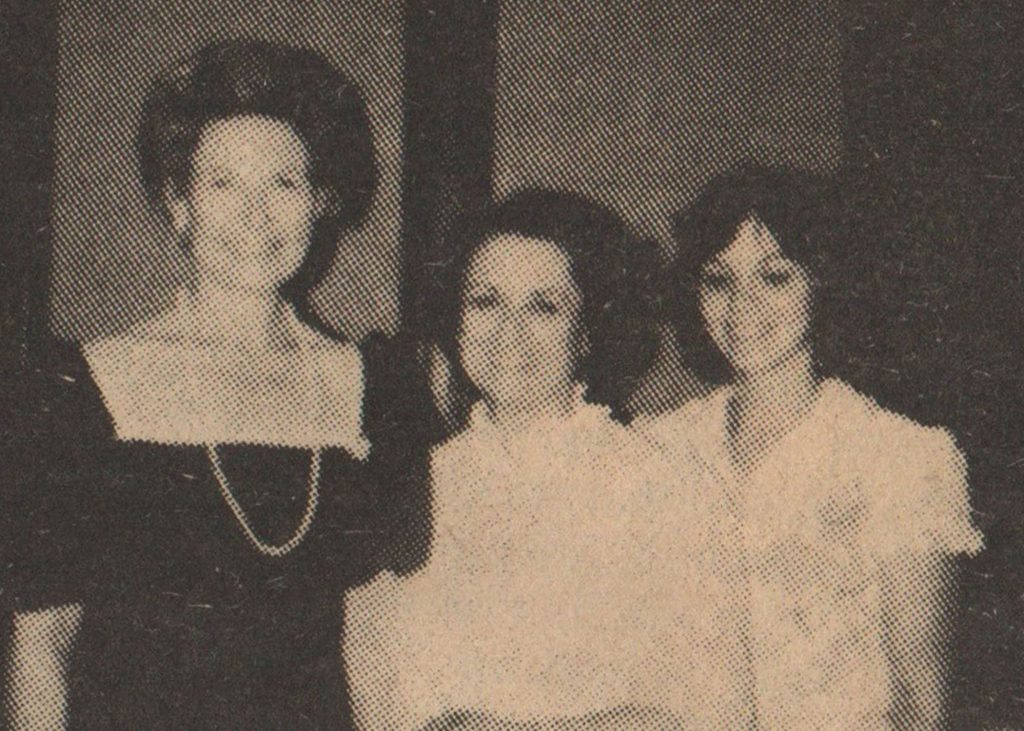Phyllis Schlafly, the longtime conservative activist and prominent antifeminist, died on Monday, September 5, 2016. Her political career spanned seven decades and indelibly shaped the histories of gender and sexuality in the postwar United States. She began her career as a staunch advocate of anti-communist foreign policy in the late 1940s and, in response to the Equal Rights Amendment in 1972, she helped popularize what became known as a “family values” platform. She tied conservative politics to the heterosexual nuclear family with the “divinely-inspired” gender roles of breadwinner father and homemaker mother. In the August 1975 edition of her monthly newsletter, Eagle Forum Newsletter, Schlafly summed up this vision: “We support the Holy Scriptures providing the best code of moral conduct yet. We support women’s rights, including: the right of a woman to be a full-time wife and mother, and to have this right recognized by laws that obligate her husband to provide the primary financial support and home for her and their children.” As historians consider her legacy, they must reflect upon how she helped politicize sexuality.

When I first started researching the role that (white) suburban Catholic homemakers in New York State played in the conservative family values take-over of the GOP, the first oral history I conducted was with Schlafly. We spoke on the phone in January of 2007, and I had high hopes that our conversation would be illuminating. I still wonder why Schlafly agreed to speak to a graduate student.
The content of our telephone interview seemed at the time to be largely useless. She repeated talking points about the ERA that I had read in countless back-issues of her newsletter—that the amendment would force women into military combat, that it would mandate unisex changing rooms and bathrooms, and so on. She was so animated in her arguments that she twice slipped into the present tense, speaking as if the ERA were still a present danger and not an issue that had been settled three decades earlier.
I concluded the interview by asking if she knew how to contact any of the women she had once inspired on the grassroots level in New York. Ever the careful organizer, she surprised me by consulting her current database of Eagle Forum supporters. In this manner, I located a dozen women with unpublished contact information that I never otherwise would have found. Despite our lackluster conversation, I still remain grateful to Schlafly, whose actions that day demonstrated the organizing prowess that had served her well in the ERA campaign and beyond.
Once I located these retired activists, I learned that when they first got started in the 1970s, they were political neophytes and busy suburban homemakers. Schlafly supplied these women with much-needed talking points and organizational strategies. Take, for instance, the hand-written note from Schlafly, dated April 1974, that one woman found tucked away in her closet. In it, Schlafly warned, “You are on sound ground if you stick to the arguments in my newsletters and do not stray afield.” So effective a mentor was Schlafly that the president of the Buffalo chapter of the National Organization for Women (NOW) complained in 1975 about having “a woman here who looks, sounds, and argues like Phyllis Schlafly.”

Schlafly did not only seek out political novices. She eagerly recruited women involved in anti-abortion activism. She knew that people who had written letters to lawmakers and protested abortion were apt to support her anti-ERA activism. Schlafly worked tirelessly to tap into existent anti-abortion networks by claiming, without evidence, that if the ERA were enacted, it would be impossible to outlaw “abortion on demand.”
So, what can historians of sexuality and gender learn from Schlafly’s political legacy?
First, the arc of Schlafly’s career shows how Schlafly and fellow family values conservatives worked—like their feminist sisters who popularized the slogan—to make “the personal political.” Her activism demonstrated that antifeminism was more than reactive. Rather, it was a very sophisticated, multi-layered political force in its own right that offered a vehicle for the aspirations and values of millions of women who disavowed feminism. The women I interviewed only got involved with the un-familial and unfamiliar realm of organized politics for deeply personal reasons. Just as they had attained their version of the American dream, which included suburban home ownership and the ability to stay at home full time unlike many of their Depression-era mothers, they faced a powerful modern feminism that seemed antithetical to their life choices. Schlafly stoked the fears of these middle-class homemakers by claiming that the ERA would compel them into the workforce while their children languished in “taxpayer-financed, universally-available childcare services for all families regardless of their income level.”

Second, much of modern American sexual politics was forged in the crucible of conflict between feminists and conservative women. At the onset of the modern feminist movement, lawmakers approved feminist-backed proposals with gusto. These overwhelmingly male legislators did so because they wanted to be re-elected; no other female consistency had yet mobilized, so male legislators assumed that feminists represented the demands of all women. The ERA’s initial success was due in part to proponents’ promise that it would eliminate remaining gender inequities in the legal code in one fell swoop. Male lawmakers liked this idea, so they could get back to “real” political work in areas such as taxation and foreign policy. Then women like Schlafly and her vast grassroots network showed that there was a viable voting bloc of women opposed to feminism. Schlafly’s activism made previously personal matters related to sexuality, gender, and the family newly contested and significant public policy debates—not peripheral or negligible affairs.
Before the ERA and advent of modern feminism, Schlafly’s politics concentrated on foreign policy and fiscal responsibility; however, she had two major strikes against her. She was a woman trying to gain traction in the male world of politics, and a conservative Republican vying for influence in a party dominated by moderates. Both factors prevented her from rising to national prominence.
Once so-called “women’s issues” moved to the center of American political life, the stage was set for Schlafly to present herself as a dissenting “housewife” opposed to feminism, abortion, and gay rights. She began crisscrossing the country and running a large, highly effective national political lobby. Ironically, she was able to do so because the feminist movement she excoriated made it easier for women to assume such leadership roles. Schlafly did not, however, fully relinquish her prior interests.
Instead, Schlafly filtered conservative calls for individual rights, smaller government, lower taxes, and more robust foreign policy through the lens of heterosexual traditional family rights. Taxation, for example, became synonymous with financing objectionable feminist initiatives, such as Medicaid-funded abortions. Higher taxes, she claimed, might also push homemakers into the paid workforce to help families make ends meet in the economic downturn of the 1970s. The media may separate economic, social, and foreign policy conservatism, but historians must trace how these points overlap.
Sexual and political conservatism merged in new ways during the 1970s—and they remain inseparable today, in part because of Phyllis Schlafly’s many decades of activism.
 Stacie Taranto is an Associate Professor of History at Ramapo College of New Jersey, where her teaching and research focus on post-1945 U.S. political and women’s history. Taranto’s book, Kitchen Table Politics: Conservative Women and Family Values in New York, will be out in March 2017 from University of Pennsylvania Press.
Stacie Taranto is an Associate Professor of History at Ramapo College of New Jersey, where her teaching and research focus on post-1945 U.S. political and women’s history. Taranto’s book, Kitchen Table Politics: Conservative Women and Family Values in New York, will be out in March 2017 from University of Pennsylvania Press.

NOTCHES: (re)marks on the history of sexuality is licensed under a Creative Commons Attribution-NonCommercial-NoDerivatives 4.0 International License.
Based on a work at www.notchesblog.com.
For permission to publish any NOTCHES post in whole or in part please contact the editors at NotchesBlog@gmail.com




